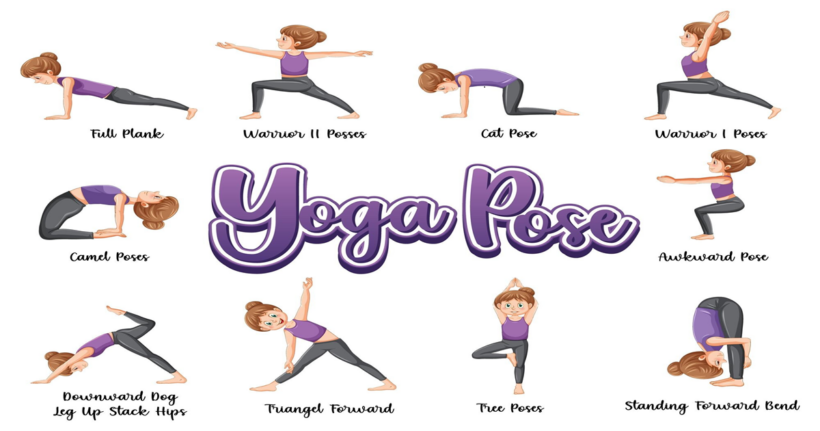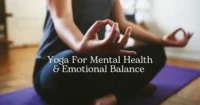Yoga, an ancient practice that originated in India over 5,000 years ago, has evolved into a global phenomenon celebrated for its physical, mental, and spiritual benefits. With its rich history and 15 types of yoga styles, yoga offers something for everyone. But with so many types available, how do you choose the one that suits you best? Let’s explore the history, benefits, requirements, and pros and cons of various yoga types to help you find your perfect match.
A Brief History of Yoga
Yoga’s roots trace back to the Indus Valley Civilization, with early mentions in ancient texts like the Vedas and Upanishads. Patanjali’s “Yoga Sutras,” written around 200 BCE, systematized yoga into eight limbs, focusing on ethical living, meditation, and physical postures (asanas). Over centuries, yoga evolved, blending with various cultural influences to develop into the diverse styles we know today.
1. Hatha Yoga
Overview
Hatha yoga offers a gentle introduction to foundational asanas combined with breathing techniques to create a balanced practice.
Common Asanas
- Downward Dog (Adho Mukha Svanasana)
- Warrior Pose (Virabhadrasana)
- Tree Pose (Vrikshasana)
Benefits
- Improves flexibility and strength.
- Reduces stress and promotes relaxation.
- Enhances focus and mindfulness.
Who Can Do It?
- Beginners looking for a slower-paced practice.
- Individuals recovering from injury or seeking low-impact exercise.
Requirements
- Comfortable clothing and a yoga mat.
- A quiet, calm space.
Pros and Cons
Pros: Easy to follow, great for beginners.
Cons: May not challenge those seeking a vigorous workout.
2. Vinyasa Yoga
Overview
Vinyasa yoga emphasizes flowing sequences that synchronize movement with breath.
Common Asanas
- Sun Salutations (Surya Namaskar)
- Plank Pose (Phalakasana)
- Cobra Pose (Bhujangasana)
Benefits
- Builds cardiovascular endurance and strength.
- Enhances flexibility and balance.
- Encourages a meditative focus on breath.
Who Can Do It?
- Intermediate to advanced practitioners.
- Those who enjoy dynamic, fast-paced workouts.
Requirements
- A yoga mat with good grip.
- Moderate fitness level.
Pros and Cons
Pros: Energetic and creative.
Cons: May feel overwhelming for beginners.
3. Ashtanga Yoga
Overview
Ashtanga yoga is a challenging practice that adheres to a structured sequence of dynamic postures to build strength and flexibility.
Common Asanas
- Triangle Pose (Trikonasana)
- Seated Forward Bend (Paschimottanasana)
- Headstand (Sirsasana)
Benefits
- Builds physical and mental discipline.
- Improves strength, flexibility, and stamina.
- Encourages self-practice and routine.
Who Can Do It?
- Experienced yogis seeking structure.
- Individuals who thrive on routine.
Requirements
- High commitment and fitness level.
- Familiarity with basic yoga postures.
Pros and Cons
Pros: Predictable and structured.
Cons: Can be repetitive and physically demanding.
4. Kundalini Yoga
Overview
Kundalini yoga combines dynamic breathing techniques, chanting, and meditation to awaken spiritual energy.
Common Asanas
- Camel Pose (Ustrasana)
- Cobra Pose (Bhujangasana)
- Sat Kriya (specific Kundalini posture)
Benefits
- Enhances mental clarity and emotional balance.
- Strengthens the nervous system.
- Promotes spiritual growth.
Who Can Do It?
- Those seeking a spiritual or meditative practice.
- Individuals open to chanting and breathwork.
Requirements
- Comfortable clothing.
- An open mind for spiritual practices.
Pros and Cons
Pros: Deeply transformative.
Cons: May feel unconventional to some.
5. Bikram Yoga (Hot Yoga)
Overview
Bikram yoga consists of 26 postures practiced in a heated room.
Common Asanas
- Triangle Pose (Trikonasana)
- Tree Pose (Vrikshasana)
- Standing Bow Pose (Dandayamana Dhanurasana)
Benefits
- Enhances flexibility through heat.
- Promotes detoxification through sweating.
- Improves stamina and focus.
Who Can Do It?
- Individuals who enjoy heat and structured routines.
- Those aiming to improve flexibility.
Requirements
- A towel, water bottle, and heat-tolerant clothing.
- High hydration levels.
Pros and Cons
Pros: Detoxifying and challenging.
Cons: Can be physically taxing and uncomfortable in extreme heat.
6. Restorative Yoga
Overview
Restorative yoga focuses on deep relaxation using props to support poses.
Common Asanas
- Child’s Pose (Balasana)
- Reclining Bound Angle Pose (Supta Baddha Konasana)
- Legs-Up-The-Wall Pose (Viparita Karani)
Benefits
- Relieves stress and tension.
- Improves sleep and recovery.
- Supports healing for chronic pain.
Who Can Do It?
- Individuals with high stress or physical limitations.
- Those seeking relaxation.
Requirements
- Props like bolsters, blankets, and blocks.
- A quiet, peaceful space.
Pros and Cons
Pros: Extremely gentle and calming.
Cons: May not appeal to those seeking physical exertion.
7. Iyengar Yoga
Overview
Iyengar yoga emphasizes precise alignment and uses props to achieve perfection in poses.
Common Asanas
- Warrior Pose II (Virabhadrasana II)
- Bridge Pose (Setu Bandhasana)
- Supported Shoulder Stand (Salamba Sarvangasana)
Benefits
- Improves posture and alignment.
- Enhances body awareness and strength.
- Accessible to all skill levels.
Who Can Do It?
- Perfectionists who value detail.
- Individuals recovering from injuries.
Requirements
- Props like belts, blocks, and chairs.
- Patience to learn techniques.
Pros and Cons
Pros: Highly accessible and safe.
Cons: Slow pace may not suit everyone.
8. Yin Yoga
Overview
Yin yoga focuses on holding gentle, passive poses for extended periods, allowing deep connective tissues and fascia to stretch and release tension.
Common Asanas
- Butterfly Pose (Baddha Konasana)
- Caterpillar Pose (Seated Forward Fold)
- Dragon Pose (Low Lunge)
Benefits
- Improves joint mobility and flexibility.
- Promotes relaxation and mindfulness.
- Enhances circulation.
Who Can Do It?
- Individuals looking for a meditative practice.
- Those wanting to improve flexibility.
Requirements
- Comfortable clothing and a yoga mat.
- Patience for long holds.
Pros and Cons
Pros: Deeply restorative and meditative.
Cons: Requires patience and stillness.
9. Power Yoga
Overview
Power yoga is a vigorous, fitness-oriented style inspired by Ashtanga yoga.
Common Asanas
- Chair Pose (Utkatasana)
- Side Plank Pose (Vasisthasana)
- Crow Pose (Bakasana)
Benefits
- Builds strength, stamina, and flexibility.
- Provides a full-body workout.
- Increases energy levels.
Who Can Do It?
- Fitness enthusiasts.
- Those seeking a high-energy practice.
Requirements
- High fitness level.
- A yoga mat with good grip.
Pros and Cons
Pros: Intense and energizing.
Cons: May not suit beginners.
10. Jivamukti Yoga
Overview
Jivamukti yoga integrates physical practice with ethical and spiritual teachings.
Common Asanas
- Warrior III Pose (Virabhadrasana III)
- Extended Side Angle Pose (Utthita Parsvakonasana)
- Lotus Pose (Padmasana)
Benefits
- Encourages mindfulness and compassion.
- Combines physical challenge with spiritual growth.
- Promotes a sense of community.
Who Can Do It?
- Individuals seeking a holistic practice.
- Those open to exploring philosophy and ethics.
Requirements
- A yoga mat and willingness to engage in discussions.
Pros and Cons
Pros: Holistic and community-oriented.
Cons: May feel intense for some.
11. Anusara Yoga
Overview
Anusara yoga emphasizes alignment and a positive, heart-opening philosophy.
Common Asanas
- Wild Thing (Camatkarasana)
- King Dancer Pose (Natarajasana)
- Half Moon Pose (Ardha Chandrasana)
Benefits
- Enhances physical alignment.
- Promotes positivity and mindfulness.
- Builds strength and flexibility.
Who Can Do It?
- Those seeking a joyful practice.
- Individuals who value alignment.
Requirements
- Comfortable clothing and a yoga mat.
Pros and Cons
Pros: Uplifting and accessible.
Cons: Less intense than other styles.
12. Prenatal Yoga
Overview
Prenatal yoga is designed to support women during pregnancy.
Common Asanas
- Cat-Cow Pose (Marjaryasana-Bitilasana)
- Goddess Pose (Utkata Konasana)
- Child’s Pose (Balasana)
Benefits
- Reduces pregnancy-related discomfort.
- Prepares the body for labor.
- Promotes relaxation and bonding with the baby.
Who Can Do It?
- Pregnant individuals at any stage.
Requirements
- Consultation with a healthcare provider.
- Props for comfort.
Pros and Cons
Pros: Tailored for pregnancy.
Cons: Limited to expectant mothers.
13. Aerial Yoga
Overview
Aerial yoga involves performing poses using a suspended hammock.
Common Asanas
- Inverted Pigeon Pose
- Flying Downward Dog
- Floating Savasana
Benefits
- Builds strength and flexibility.
- Reduces joint compression.
- Adds an element of playfulness.
Who Can Do It?
- Adventurous individuals.
- Those seeking low-impact exercise.
Requirements
- Access to aerial hammocks.
- Basic fitness level.
Pros and Cons
Pros: Fun and unique.
Cons: Requires specialized equipment.
14. Sivananda Yoga
Overview
Sivananda yoga follows a structured sequence focusing on five principles: proper exercise, breathing, relaxation, diet, and meditation.
Common Asanas
- Cobra Pose (Bhujangasana)
- Bow Pose (Dhanurasana)
- Seated Forward Bend (Paschimottanasana)
Benefits
- Enhances physical and mental well-being.
- Promotes holistic health.
- Deepens spiritual awareness.
Who Can Do It?
- Those seeking a traditional practice.
- Individuals interested in lifestyle changes.
Requirements
- A yoga mat and open mind.
Pros and Cons
Pros: Holistic and accessible.
Cons: May feel slow-paced.
15. AcroYoga
Overview
AcroYoga combines yoga with acrobatics and partner work.
Common Asanas
- Flying Plank
- Star Pose
- Throne Pose
Benefits
- Builds trust and communication.
- Improves strength and coordination.
- Encourages teamwork.
Who Can Do It?
- Those seeking a partner-based practice.
- Fitness enthusiasts.
Requirements
- A partner and open space.
Pros and Cons
Pros: Social and interactive.
Cons: Requires a partner and physical effort.
Choosing the Right Yoga for You
Choosing the ideal yoga type hinges on understanding your goals, fitness level, and unique preferences. Here’s a concise guide:
- For relaxation and stress relief:Try Hatha, Restorative, Yin, or Kundalini yoga.
- For physical fitness:Vinyasa, Ashtanga, Power, or Bikram yoga.
- For alignment and precision:Iyengar, Anusara, or Sivananda yoga.
- For spiritual growth:Kundalini, Jivamukti, or Sivananda yoga.
- For unique experiences:Aerial, AcroYoga, or Prenatal yoga.
Conclusion
Yoga is a transformative journey of self-discovery, offering a harmonious blend of physical strength, mental clarity, and spiritual growth. With 15 types of yoga to explore, every practitioner—from curious beginners to seasoned yogis—can find a style that resonates. Embrace the adventure, and let yoga lead you to a healthier, more balanced, and fulfilling life.


